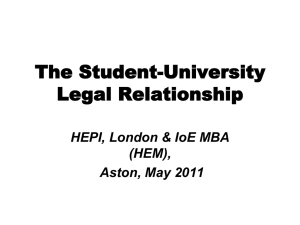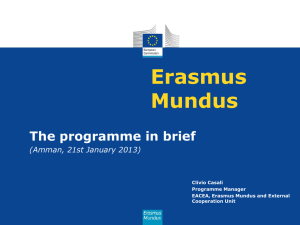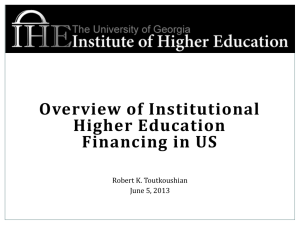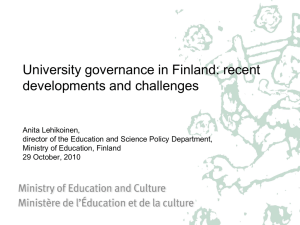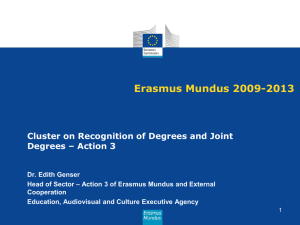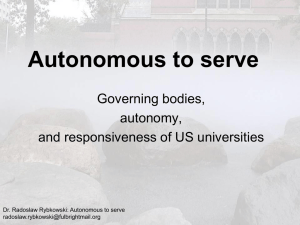Zróżnicowanie, rankingi i konkurencja w szkolnictwie wyższym
advertisement
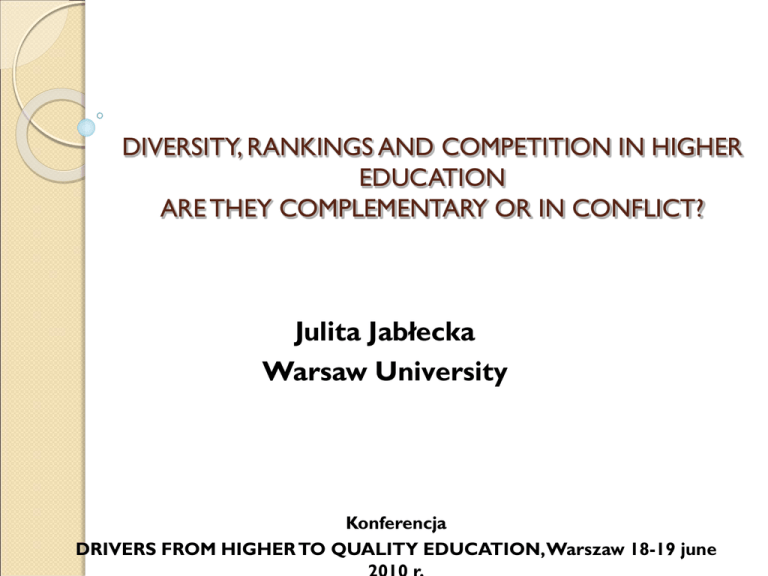
DIVERSITY, RANKINGS AND COMPETITION IN HIGHER EDUCATION ARE THEY COMPLEMENTARY OR IN CONFLICT? Julita Jabłecka Warsaw University Konferencja DRIVERS FROM HIGHER TO QUALITY EDUCATION, Warszaw 18-19 june Plan of presentation 1. 2. 3. 4. 5. 6. Higher education context. Forms of diversity and their meaning for university rank as superior quality External determinants of diversity changes in higher education Competition, autonomy and rankings Basic factors of outstanding world class university Polish HE system. Is any chance for HEIS to achieve high position in global rankings? Context Trends in higher education environment: Globalization, international competition in economy, research and higher education Knowledge base economy- the role of high quality specialists, and innovations: Demands to HE: Diversity: increased (universal?) access to higher education versus emergence of elite universities with excellent research quality and productivity ◦ Competition and autonomy Diversity in HE: (Birnbaum1983, Huisman, 1995, 2000, Meek, Goedegebuure, Kivinen, Rinne 1996,Van Vught, Reichert 2009). ◦ ◦ ◦ ◦ ◦ 1. allows to meet students’ needs 2. provide opportunities for social mobility 3. meet the needs of different labor markets (with an increasing variety of specialisations) 4. serve the political needs of interest groups 5. permit the combination of elite and mass higher education Diversity allows to: (cont.) ◦ 6. increase the level of higher education institutions’ effectiveness (cf. Carnegie Commission 1973) ◦ 7. offer opportunities for experimenting with innovation in a few institutions thus limiting the high risks connected to the failure of such an experiment 1.8. permit to concentrate rather on undergraduate on education or graduate edu and research/knowledge creation (jabłecka) (underlined are important for emergence of highest class HEIs and –as a consequence- ranked universities) Three main forms of diversity: External (between HEIs) versus internal (within HEIs) horizontal (different missions, type of HEIs) versus vertical (I, II, III level of education) Formal ( education level) versus informal (reputation) Categories of diversity Birnbaum (1983) a za nim kilku kolejnych autorów (Fairweather 2000 Goedegebuure & Meek 1997 oraz Meek 2000) 1 systemic (institutional type, size, control) 2 structural (resulting from historical and legal foundations), 3 programmatic (degree level, degree area, comprehensiveness of mission) 4 procedural( in the ways that teaching, research and /or services are provided Categories of diversity cont. 5 reputational (based on status and prestige); 6 constituential (in students, faculty, administration); 7 values and climate (in social environment & culture). (1,3,5 and 7 categories important for emergence world class ranked University) Diversity-ranking relations Combination of systemic (type), programatic (mission), values and climate (high quality culture) and reputational /quality diversity are favorable for emergence of elite research HEIs Emergence of elite HEIs is a condition of receiving high ranking position High ranking position leads to encrease of prestige/reputation Drivers of differentiation/ de-differentiation in HE (from theoretical and empirical literature) 1. Izomorfizm (normative)- professioonalism, common norms & values- academic drift (less prestigious institutions emulate leaders). Van Vught (2008): the larger the influence of academic norms and values in HEI, the lower the diversity in HE system Competition 2.1. for students, financial resources, faculty may increase diversity (specialised profile) 2. Drivers of de/-differentiation cont. 2.2. Competition for prestige: negative and positive consequences 1.To be high prestige institutions requires more selected, more excellent (expensive) faculty and students, more expensive infrastructure- resulting in increasing cost 2. if public resources are limited- there is intensive competition, selection and concentration of public funding. 3.In competiton for prestige wealth institutions have more resources to attract the best faculty and students and increase their advantage 4. Both financial and reputation concentration lead to decreasing horizontal (mission) diversity and to increasing informal vertical diversity (better and worse) EXTERNAL (FORMAL) CONTEXT ENCANCE/INHIBIT DIFFERENTIATION 1. LEGAL REGULATIONS ENHANCE D. IF INSTITUTIONAL TYPES ARE FIRMLY ESTABLISH, NOT TRANSFER BETWEEN IS ALLOWED ENABLE HOMOGENZATION IF TRANSFER BETWEEN TYPES OF HEIs IS POSSIBLE UNDER SOME CONDITIONS ENHANCE HOMOGENIZATION IF NO FORMAL DIFFERENCES OF INSTITUTIONAL TYPES EXTERNAL (FORMAL) CONTEXT ENCANCE/INHIBIT DIFFERENTIATION, cont. 2.FUNDING OF HEIs 2.1. WHEN DIVERSIFIED MECHANISMS/CRITERIA, AVAILABILITY OF FUNDS ACCORDING TO TYPES, CONTROL, OR PROFILE MORE FUNDING SOURCES SEVERE COMPETITION: GRANTS, OTHER RESEARCHPROJECTS (WINNERS/LOOSERS)- EFFECT:INCREASED DIVERSITY, INCREASED POLARISATION, CONCENTRATION OF FUNDS 2.2. WHEN UNIFIED FUNDING CRITERIA, FUNDS FOR ALL INSTITUTIONS NON-COMPETITIVE FUNDINGEFFECT: DECREASING DIVERSITY EXTERNAL (FORMAL) CONTEXT ENCANCE/INHIBIT DIFFERENTIATION cont. 3. ACCREDITATION SYSTEMS AND CRITERIA OF QUALITY ASSURANCE: IF UNIFIED- HOMOGENIZATION IF DIVERSIFIED- MAINTAINING DIVERSITY EXTERNAL (FORMAL) CONTEXT ENCANCE/INHIBIT DIFFERENTIATION Increase of institutional autonomy allows for emulation of successful prestigious HEIs (academic drift): decreasing diversity Competition, autonomy and chance for a better position in rankings Aghion et al. (2008): Research in the USA and several european countries 1. University autonomy and competition positively correlated with output measured with index of indicators from shanghai ranking and number of patents explanation 2. Governments do not know which research is on the frontier of knowledge, and the most promissing so they establish quasi-competition for research money between HEIs. HEIS enjoing autonomy are able to make a better use from the competition 3. The authors analyzed such autonomy dimensions as: institutional autonomy to determine educational prcurricula, selection of students, faculty selection, determining the level and diversifying wages of faculty on the same positions. Freedom in budgetary matters, a share of government basic institutional grants and grants in research revenues. Key characteristics of World class universities (Alden i Lin 2004, cyt. za Salmi 2008) I divided 23 features into 4 groups: Potencial (strategic capacity) Strategic directions, Output Outcome For Polish elite universities: measures +++ very high ++ high + low 0 =0 1. Potencial (strategic capacity) Atracting the most able students (undergrad.++ Attracting and retaining the best staff + Możliwości przyciągania studentów i kadry na rynku międzynarodowym0 Attracting a high proportion of posgrad. Students taught and research 0 Potencial (strategic capacity) cont. Has a very sound financial base 0 Receives high endowment capital and income 0 Has diversified sources of income (gov,. private comp., research income, intern students fees +0 Provides a high quality and supportive R+edu. Environment for staff and students 0 Has a first class management team with strategic vision and implementation plans 0 2. Strategy, strategic areas Identifies and builds on its research strenghts and has a distinctive reputation nad focus on its lead subjects 0 Operaties within global market and is international in many activities – research links, student and staff exchange, throughput of visitors of international standing 0 Continually benchmarks with top universities and departments worldwide0/+ Strategy, strategic areas cont. Has the confidence to set its own agenda ++ Has a number of world class departments (not neccessarily all) +/0 Has a number of research stars and world leaders in their fields 0 Output Generates innovative ideas and produces basic and applied research in abundance 0/+ Produces path breaking research output recognized by peers e.g. nobel prise Winners 0 Produces graduates who end up with positions of influence and/ ora power i.e. movers and shakers, e.g. Prime Ministers and presidents 0/+ 4. Outcomes International reputation for its research 0/+ International reputation for its teaching 0 It is recognized not only by other world class universites but also outside the world of HE 0 Makes a big contribution to society and our times 0 Conditions for emergence of candidates for ranking positions of Polish HEIs Systemic diversity and elite HEIs : system inherited from communism (narrow HEIs profile), plus formal diversification (by law 2005) into different profiles and levels of education based on number of professors introduces (practically) vertical stratification. Possible transfer between categories= stimulates academic drift No elite universities involved in research and advanced teaching on II, and III level of education Conditions for emergence of candidates for ranking positions of Polish HEIs cont. Values norms and organizational climate rather uniform: strong academic norms (path dependent) especially in old pestigious universities, basic reasearch, autonomy , collegiality : inhibiting radical restructuring Funding: majority of HE and research funding from government Institutional formula (mostly imput) funding based on lump-sum grants Tuition fees dominate in private sector and are charged in public sector for part-time studies Conditions for emergence of candidates for ranking positions of Polish HEIs cont. Research funding –majority of funding (50-75%) through institutional performance funding (low competitiveness due to construction of funding formula and criteria). All public HEIs receive such funding and several private HEIs but generally private sector HEIs are not eligibledo not fulfill requirements. Project funding is competitive but its share in research funding has been between 15-20 % in 1990-2009. Conditions for emergence of candidates for ranking positions of Polish HEIs cont. About 140 HEIs formally combine educational and research function Organizational diversity: managerial model of governance, exist only in private sector, attemps to set up strategy is the latest phenomenon Autonomy and competition- do they exist and how they are used in Polish HE. Dimensions of institutional autonomy: 1. Determining curricula- limited by uniform standards of education , tendency to offering the most popular programs instead of institutional and program speclialization (unique programs) 2. Selection of students: almost exclusively based on degrees of diploma from high schools, but for private HEIs and part-time public education- no selection. Between I and II level of education- seldom any sdelection Autonomy and competition in Polish HE cont. 3. Faculty selection- nominally contst for a position, in practice do not work properly. Inbreeding and lack of interuniversity mobility. Employing own PHD holders is a rule 4. Financial autonomy of spending- full 5. A share of noncompetitive funding- such funds dominate, share of competitive funding of research projects makies up 15-20 %. Conclusions 1. 2. In Poland both external and internal conditions are not favorable for emergence of elite international universities 2. Key features of international class universities are difficult to find in Polish HEIs. DZIĘKUJĘ ZA UWAGĘ Thank you for your attention


